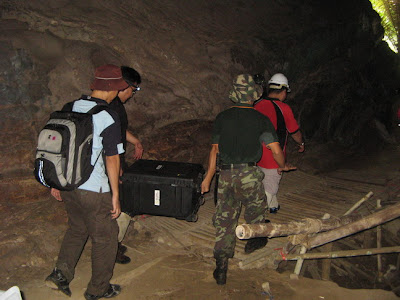The 3D mapping of caves with laser scanners has been tried in England and other European countries over the past decade, but has never really caught on. The best use for it seems to be to determine the size (volume) of large chambers. And for a 3D tour through caves for armchair cavers!
In Oct 2009 I was invited to join a group from UTM who were trying out a scanner in caves in Lenggong in Perak. None of the team were familiar with caves. Their idea is to scan caves "to generate a hyperaccurate 3D maps with 2mm resolution within a 25m radius. It can effectively scan every aspect of the cave including its speleobiology". I really have my doubts about the latter claim. They then suggested it could help bat researchers to identify species. However I think this is not very practical, and certainly not down to species level, and bats would still have to be caught and identified, or else bat detectors used. Although the claim is it can detect anything above 6mm in its 120m range, and 2mm in a 25mm range, this certainly won't show bat species, and definitely not the smaller cave creatures.
One problem is transportation, as the scanner in its box weighs about 24 kg and out of the box about 14 kg. It comes in 4 sections. It's easy enough to scan in a chamber with a single set-up for the laser scanner, but would become very tedious in a cave passage needing multiple set-ups.
booting up the computer
placing the markers
Carrying the equipment and setting it up in the next cave -
placing the markers again
The bats
Looking at the results
I took some info from the Faro www, Faro is the maker of the scanner.
FARO Laser Scanner LS
With the Laser Scanner LS, FARO offers a 3D measurement device, capable to capture large volumes within a very short time.
Captures 3D environment in a highly precise way.
Measuring procedure begins in the laser unit. A rotating mirror directs the laser beam into the area of measurement. Distances determined by the phase shift of the reflected laser beam opposite the transmisison beam. With the help of the angle of the rotating mirror and the angle of the laser scanner, the module calculates the coordinate and stores the data. Procedure is repeated several hundred thousand times per second.
In May 2010 new items reported on scanning the Nottingham Caves in UK, and gave some useful information on the scanning.
---------------
See 3D scanning Wang Burma.
© Liz Price
No reproduction without permission

















Definitely looks better with scanner
ReplyDeleteJust like you can't identify insect with a photo.
ReplyDeleteNo. Insects require actual specimens to ID, many are identified by their genitalia etc. Even bats you need to measure things like jaw size.
ReplyDelete